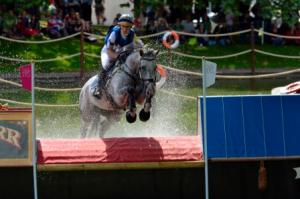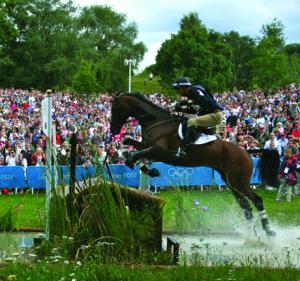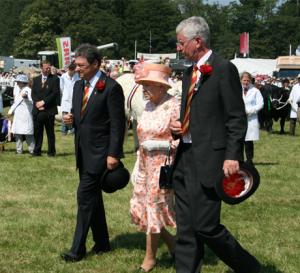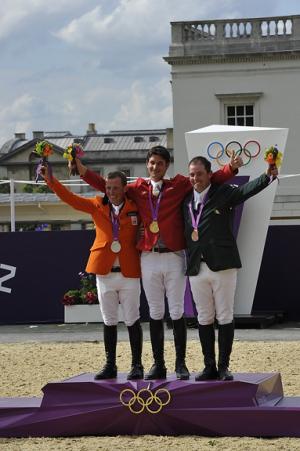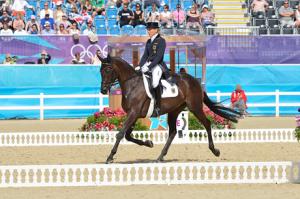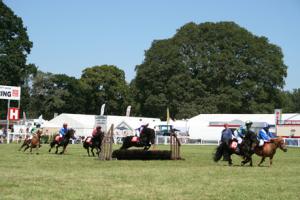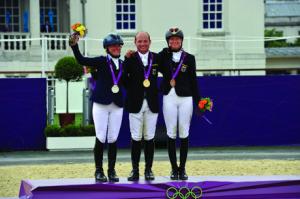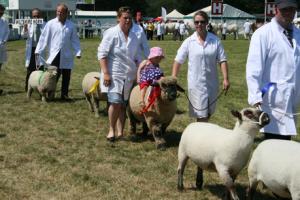From the Mid-South Horse Review London Bureau
By Peggy Hart
Ever since my daughter Cary accepted a position at the ACS Egham International School in Egham, England, a suburb of London, three years ago, we have been making plans to attend the 2012 London Olympics. On July 18, 2012 I boarded a plane to Heathrow Airport, and our adventures began.
New ForestPony Show Journal
Before going to the Olympics, we spent three days at the New Forest and Hampshire Agricultural Show, where Cary’s friend Lyndon Barrow of Dibden, was a steward for the pony classes. Set aside as a hunting ground by William the Conqueror 900 years ago as his “New” Forest it is approximately 50 square miles of woods, with the remainder in heather, bracken-clad heath, and open pastureland and marshy ground. Ponies, donkeys, cattle, sheep and pigs wander the forest freely and are owned by the forest inhabitants known as commoners. The traditions and atmosphere are preserved by a system of Verderers who are responsible for managing the administration of the park and Agisters who manage the livestock and wildlife. The animals have the right of way and people are just visitors.
Traffic jams occur often as the critters wander down a road or meander across one. There are no fences except around the perimeter of the forest to keep the animals in, and around people’s homes to keep the animals out.
Our first visit was to the Farrier's Stud where we met Shirley and Simon Youngwho raise New Forest ponies. The Brock herd of New Forest ponies was established in 1870 and is the oldest recorded herd still running the Forest today. All the ridden ponies at the Farrier’s stud are used to round up the herd in the annual drifts across the New Forest.
[For more information see: www.farriersnewforestponies.co.uk/welcome]Will, their trainer and rider, had just become the proud owner of two Traditionals, known as Gypsy Vanners in the U.S. Will had bought the mare at the Beulieu Auction and he got two for the price of one! Simon and Shirley took their stallion Farriers Fingerprint (Buster), with Will up, and one of Buster’s offspring, Farriers True Print (Lotty), with Shirley up, to the New Forest Show. The mare won Champion in the New Forest Ridden Class and Buster was Reserve Champion.
The following day, Sunday, we watched Cary’s friend Lyndon show her weanling, Marmite her recently gelded Welsh section A, at his first show in a young stock class. Since the shows cover expenses only, all the officials at British horse shows, whether a large show or small, are volunteers, including the judges and stewards. One judge flew in from South Africa to officiate at the New Forest Show. Some judges are designated “riding judges” and actually get on the competitor’s horses to see how they go.
On Tuesday we headed to the New Forest Show grounds. Set up at a large equestrian facility, where just days before there had been pastures, were two extremely large arenas and two smaller arenas, all grass, that would stay busy with horse classes from early morning until nightfall for the next three days. A midway kept the children happy with every kind of ride imaginable. Huge tents held cattle being judged, sheep, rabbits, exotic birds, and fowl were close by along with every type of vendor from exclusive harness makers, tack and riding attire vendors, to people selling “WOW” cleaning cloths. Row after row of vendors, demonstrations, displays and food sellers reminded me of the old Mid-South Fair at the Fairgrounds in Memphis. The Countryside Alliance, working to repeal the ban on fox hunting, had a whole corner of the main row, giving demonstrations of falconry, sporting dogs, i.e., Labradors retrievers and bird dogs like Springer Spaniels, police dogs, and even a demonstration on how to hunt a ferret.
Best of all were the ferret races, where the ferret wins by a tail. A system of pipes with open cages at the end are set up as a course. With much fanfare, the ferrets, each with his own “colors,” are released into the pipes. Some came out and went back in, or sat in the cages grooming themselves. Eventually one would decide to see what was at the end and stick his nose out; but he only won if his tail came out too. The winner of the race I watched came out completely, examined the cheering crowd, and promptly went back in.
Ponies Galore!
We saw Moor & Mountain (M&M) breeds used from everything from hunting, showing, and eventing to hauling game down the mountains of Scotland. We watched Shetland ponies being shown, with even a Shetland Grand National with children jumping small steeplechase jumps. The M&M small breeds are Shetland, Exmoor, Dartmoor, Welsh, Eriskay, and Kerry Bog breeds; the large the Connemara, Highland, Dales, Fell, and New Forest breeds.
Lead line classes are for children under age 7, riding hunter or show type ponies. Hunter type is a pony who could go out for a day’s hunting, shown in plain leather bridles with riders in hacking jackets, while the show type is finer, shown in ribboned brow bands and riders in navy jackets.
In working hunter classes, jumping classes, and all others, ponies were were being shown by adults as well as children. They take ponies seriously in England!
There were also classes for the larger riding horses: pleasure riding, the cobs, the maxi-cobs, and the coloreds, aka as Paints. Show jumping was held every day with several Gambler’s Choice classes, Grand Prix classes, Speed Classes, and “Seven and Out,” in which the horses are ridden on the same course seven times, each time the fences being raised. A process of elimination crowned the winner.
There were classes for the heavy horses: Shires, the Suffock Punch, Belgians, and Fresians. The heavies were shown in hand and pulling everything from farm equipment to work wagons, pleasure carriages and stage coaches.
The horses were braided in their breed-specific style. The pleasure carriage horses included the high stepping Hackneys, Cleveland Bays, and other varieties. The Coaches were assembled with driver, two footmen, six to eight passengers, and the guard who blows a long silver horn to announce their arrival.
There were parades of the hounds by the New Forest Hunt and the Wilton Hunt, and spectators were invited to pet the hounds. There was a young girl who had hearing and seeing disabilities, but still rode in regular classes by stationing a person at each corner of the arena to focus on; she placed! There were Breed classes, with the babies running along side their mothers. And, of course, there was the Queen. Her Majesty Queen Elizabeth and Prince Phillip attended the second day of the show to view the New Forest ponies, as the last stop of her Diamond Jubilee tour.
Back to LondonWe visited Camden, an international market, filled with everything imaginable. Built at the crossroads for the canals, trains, and horse drawn haulers, it is located in a huge stable. Gigantic bronze sculptures of horses pulling wagons, farriers putting on shoes, and statues of horses are around every corner. A plaque on the wall tells the story of hundreds of dray animals used to move the commerce of an entire country. The stables went far underground and included tunnels for the horses to be driven through to protect them from the noise and confusion from above with the trains and traffic. Included was a veterinarian hospital, as well as the stalls, which were now filled with vendors. Over 400 hundred horses lived and worked here.
2012 OlympicsEventing
Finally came cross country day at the Olympics, held at Greenwich Park, which is only 165 acres and had to accommodate not only the cross country course, but also the equestrian stadium, the warm up rings, and stabling. The park was hilly, so the cross country course went up then down the hills twice, with the tracks in many cases paralleling each other. This meant that the course was very tight and technical, rather than a wide open galloping course like at the Kentucky Three Day Event in Lexington.
By 6:00 a.m. we were on the train headed for London from my daughter’s apartment in Ascot. As we stepped out of the train station, we were greeted by volunteers in the purple and pink uniforms of the Games directing us with cheerful “Good Morning!” “Welcome to the Games!” and “We’re happy you came!” Since we arrived early before the gates opened, we spent time talking to others waiting in the “queue.” Finally they opened the gates and a flood of people made their way through security onto the grounds of Greenwich Park, home of the Royal Astronomical Society and Greenwich Mean Time. First order of business was to walk the course, see all the jumps, and watch some of the competitors, like Boyd Martin, do their last course walk before the start of the competition at 12:00.
Each cross country jump represented some aspect of English life: a wicker chess set; the market combination of a log to ditch to a skinny; the Timeline Clocks, with clocks showing the current time in various countries participating in the Olympics; to the River Bank aka the “Wind In The Willows” water complex. The combinations were straight forward and the fly fences lovely. It was the changes in footing and terrain that influenced how this course would ride.
As we walked the course, we watched the competitors as they took their last course walk and made decisions on how they would ride this challenging venue. We watched as the competitors climbed up the slope to the drop, only to find that it was still over their heads! It was a tricky obstacle; one that took courage from both horse and rider.
At 12:00 sharp the competition began with Boyd Martin on Otis Barbotiere for the USA as the first rider. What a rush to see him gallop by! As first US team member out, he would tell the rest of the team how the course rode. Later he had to withdraw from the Show Jumping phase.
The crowd responded to every rider on course from whatever country; but when a British rider came on course, you could hear the resounding roar and could follow their progress from the excitement of the crowds as they rode through each obstacle.
We watched Karen O’Conner, USA have to endure a 20 minute hold at the start gate. Her horse Mr. Medicott blasted out of the start box when she was finally allowed to go. We saw Ingrid Klimke, daughter of Dr. Reiner Klimke Gold Medalist at the Los Angeles Olympics on Aldrich in dressage and a Gold medal winner in her own right in dressage, as she flew the course with little problems. She was a member of this year’s Gold Metal German Team. The Australians, lead by Andrew Hoy, put on a fantastic show, but this was not their year.
One of the best riders to see was Mary King on Imperial Cavalier taking the big drop, the one that was taller than the men standing under it. Her horse never hesitated, but cleared the drop in such a leap that he landed not on the slope - but at the bottom of it with Mary’s hands on the buckle of the reins! It is said, “Look where you want your horse to go and he will go there,” and that is exactly what she did. She looked at the skinny two strides in front of her horse, closed her legs, and he flew the jump. It was glorious!
Two of the best of the 74 riders went last, starting with William Fox-Pitts. We watched as he negotiated the Wind in the Willows Jump that was a steep downhill, to a tight right hand turn, into the water, and to an oxer designed to look like a river barge. Previous horses jumping into the water ran out of room going to the barge, but Fox-Pitts’ horse Lionheart galloped in and nailed the barge before proceeding 3 strides to the log and jumping out on an angle over Ratty’s house. Next was Mark Todd of New Zealand. In 1984 Cary and I watched him on the legendary event horse Charisma, the only horse to win two consecutive Olympic Eventing Gold Medals. I was lucky enough to see him ride again in Atlanta in 1996 and now in 2012 Cary and I saw him ride another Olympic course on Campino, and he was burning up the course!
As soon as cross country was finished, we watched the volunteers begin to dismantle the jumps. This course would disappear in 24 hours and the park back as it had been, a beautifully landscaped botanical garden, although the arenas would stay up for the show jumping and dressage.
Dick Francis Country
After resting up for a day, we set off for a very special place. A Dick Francis fan for years, I wanted to see some of the places he wrote about in his books. As you drive down the winding, narrow roads between the hedgerows of England, it is hard to get a view of some of the land. But as we topped a hill, I saw the most beautiful scene I have been privileged to see. There in front of us were green hedgerows and fields of golden wheat across a valley with the morning mist still on it. This was the Vale of the Horse, and we were headed to the town of Lambourn one of the premier racing towns of England. The Downs on the hillsides are where the horses are exercised and trained. We stopped in the village, with its High Street and shops, and asked where we could see the gallops. A storekeeper answered, “If they are out, just go up the hill and you will see them on either side of the road.” As we left the town and drove up the hill, the valley once again presented its beauty. We waited beside the road only a short time and we were in luck. The chill of the morning and the wind masked the sound; we had almost climbed back in the car to leave when we saw them galloping up the rise of the hill on soft green grass in groups of two and three, flying past us with their manes and tails streaming behind them and their jockeys poised in their stirrups. These wonderful creatures can “fly without wings!”
As my time in England drew to a close, there was one more trip to make back into to London. We visited the British Museum where the Saudi Arabian government sponsored a display on the history of the horse, emphasizing the Arabians’ impact on the Thoroughbred industry.
Also in this display was a George Stubbs treasure. George Stubbs was one of the greatest equine artists of all time, and the first to actually study the anatomy of horses. He and his wife spent 18 months dissecting the cadavers of horses, so that when he painted them, they would be anatomically correct. Most horse people have probably seen his paintings, especially his famous Whistlejack, but his drawings have not been so available. In the display of Arabian horses and pictures of foundation sires of Thoroughbred horses of today was a Stubbs folio.
Also in the British Museum are the Elgin Marbles, the frieze of horses, soldiers, kings and gods that encircled the Parthenon of Athens, Greece. Sent to England by Lord Elgin in the 1800s, they have survived, while much of the Parthenon has been damaged. These carvings from 438 BC reflect the age-old love of man for these beautiful creatures. While they were seen mainly as animals bringing victory in war, the carvers of these and the Assyrian Freizes, from the country now known as Syria, displayed the horse as creatures of beauty.
I look forward to my next adventure in England! Next time we might visit the Island of Shetland, Ireland home of the Irish Draught and the Connemara, and Wales to see the wild ponies in the hills, and Scotland to ride the stout Highlands. Watch for the next episode from the MSHR London Bureau.
By Peggy Hart
Ever since my daughter Cary accepted a position at the ACS Egham International School in Egham, England, a suburb of London, three years ago, we have been making plans to attend the 2012 London Olympics. On July 18, 2012 I boarded a plane to Heathrow Airport, and our adventures began.
New ForestPony Show Journal
Before going to the Olympics, we spent three days at the New Forest and Hampshire Agricultural Show, where Cary’s friend Lyndon Barrow of Dibden, was a steward for the pony classes. Set aside as a hunting ground by William the Conqueror 900 years ago as his “New” Forest it is approximately 50 square miles of woods, with the remainder in heather, bracken-clad heath, and open pastureland and marshy ground. Ponies, donkeys, cattle, sheep and pigs wander the forest freely and are owned by the forest inhabitants known as commoners. The traditions and atmosphere are preserved by a system of Verderers who are responsible for managing the administration of the park and Agisters who manage the livestock and wildlife. The animals have the right of way and people are just visitors.
Traffic jams occur often as the critters wander down a road or meander across one. There are no fences except around the perimeter of the forest to keep the animals in, and around people’s homes to keep the animals out.
Our first visit was to the Farrier's Stud where we met Shirley and Simon Youngwho raise New Forest ponies. The Brock herd of New Forest ponies was established in 1870 and is the oldest recorded herd still running the Forest today. All the ridden ponies at the Farrier’s stud are used to round up the herd in the annual drifts across the New Forest.
[For more information see: www.farriersnewforestponies.co.uk/welcome]Will, their trainer and rider, had just become the proud owner of two Traditionals, known as Gypsy Vanners in the U.S. Will had bought the mare at the Beulieu Auction and he got two for the price of one! Simon and Shirley took their stallion Farriers Fingerprint (Buster), with Will up, and one of Buster’s offspring, Farriers True Print (Lotty), with Shirley up, to the New Forest Show. The mare won Champion in the New Forest Ridden Class and Buster was Reserve Champion.
The following day, Sunday, we watched Cary’s friend Lyndon show her weanling, Marmite her recently gelded Welsh section A, at his first show in a young stock class. Since the shows cover expenses only, all the officials at British horse shows, whether a large show or small, are volunteers, including the judges and stewards. One judge flew in from South Africa to officiate at the New Forest Show. Some judges are designated “riding judges” and actually get on the competitor’s horses to see how they go.
On Tuesday we headed to the New Forest Show grounds. Set up at a large equestrian facility, where just days before there had been pastures, were two extremely large arenas and two smaller arenas, all grass, that would stay busy with horse classes from early morning until nightfall for the next three days. A midway kept the children happy with every kind of ride imaginable. Huge tents held cattle being judged, sheep, rabbits, exotic birds, and fowl were close by along with every type of vendor from exclusive harness makers, tack and riding attire vendors, to people selling “WOW” cleaning cloths. Row after row of vendors, demonstrations, displays and food sellers reminded me of the old Mid-South Fair at the Fairgrounds in Memphis. The Countryside Alliance, working to repeal the ban on fox hunting, had a whole corner of the main row, giving demonstrations of falconry, sporting dogs, i.e., Labradors retrievers and bird dogs like Springer Spaniels, police dogs, and even a demonstration on how to hunt a ferret.
Best of all were the ferret races, where the ferret wins by a tail. A system of pipes with open cages at the end are set up as a course. With much fanfare, the ferrets, each with his own “colors,” are released into the pipes. Some came out and went back in, or sat in the cages grooming themselves. Eventually one would decide to see what was at the end and stick his nose out; but he only won if his tail came out too. The winner of the race I watched came out completely, examined the cheering crowd, and promptly went back in.
Ponies Galore!
We saw Moor & Mountain (M&M) breeds used from everything from hunting, showing, and eventing to hauling game down the mountains of Scotland. We watched Shetland ponies being shown, with even a Shetland Grand National with children jumping small steeplechase jumps. The M&M small breeds are Shetland, Exmoor, Dartmoor, Welsh, Eriskay, and Kerry Bog breeds; the large the Connemara, Highland, Dales, Fell, and New Forest breeds.
Lead line classes are for children under age 7, riding hunter or show type ponies. Hunter type is a pony who could go out for a day’s hunting, shown in plain leather bridles with riders in hacking jackets, while the show type is finer, shown in ribboned brow bands and riders in navy jackets.
In working hunter classes, jumping classes, and all others, ponies were were being shown by adults as well as children. They take ponies seriously in England!
There were also classes for the larger riding horses: pleasure riding, the cobs, the maxi-cobs, and the coloreds, aka as Paints. Show jumping was held every day with several Gambler’s Choice classes, Grand Prix classes, Speed Classes, and “Seven and Out,” in which the horses are ridden on the same course seven times, each time the fences being raised. A process of elimination crowned the winner.
There were classes for the heavy horses: Shires, the Suffock Punch, Belgians, and Fresians. The heavies were shown in hand and pulling everything from farm equipment to work wagons, pleasure carriages and stage coaches.
The horses were braided in their breed-specific style. The pleasure carriage horses included the high stepping Hackneys, Cleveland Bays, and other varieties. The Coaches were assembled with driver, two footmen, six to eight passengers, and the guard who blows a long silver horn to announce their arrival.
There were parades of the hounds by the New Forest Hunt and the Wilton Hunt, and spectators were invited to pet the hounds. There was a young girl who had hearing and seeing disabilities, but still rode in regular classes by stationing a person at each corner of the arena to focus on; she placed! There were Breed classes, with the babies running along side their mothers. And, of course, there was the Queen. Her Majesty Queen Elizabeth and Prince Phillip attended the second day of the show to view the New Forest ponies, as the last stop of her Diamond Jubilee tour.
Back to LondonWe visited Camden, an international market, filled with everything imaginable. Built at the crossroads for the canals, trains, and horse drawn haulers, it is located in a huge stable. Gigantic bronze sculptures of horses pulling wagons, farriers putting on shoes, and statues of horses are around every corner. A plaque on the wall tells the story of hundreds of dray animals used to move the commerce of an entire country. The stables went far underground and included tunnels for the horses to be driven through to protect them from the noise and confusion from above with the trains and traffic. Included was a veterinarian hospital, as well as the stalls, which were now filled with vendors. Over 400 hundred horses lived and worked here.
2012 OlympicsEventing
Finally came cross country day at the Olympics, held at Greenwich Park, which is only 165 acres and had to accommodate not only the cross country course, but also the equestrian stadium, the warm up rings, and stabling. The park was hilly, so the cross country course went up then down the hills twice, with the tracks in many cases paralleling each other. This meant that the course was very tight and technical, rather than a wide open galloping course like at the Kentucky Three Day Event in Lexington.
By 6:00 a.m. we were on the train headed for London from my daughter’s apartment in Ascot. As we stepped out of the train station, we were greeted by volunteers in the purple and pink uniforms of the Games directing us with cheerful “Good Morning!” “Welcome to the Games!” and “We’re happy you came!” Since we arrived early before the gates opened, we spent time talking to others waiting in the “queue.” Finally they opened the gates and a flood of people made their way through security onto the grounds of Greenwich Park, home of the Royal Astronomical Society and Greenwich Mean Time. First order of business was to walk the course, see all the jumps, and watch some of the competitors, like Boyd Martin, do their last course walk before the start of the competition at 12:00.
Each cross country jump represented some aspect of English life: a wicker chess set; the market combination of a log to ditch to a skinny; the Timeline Clocks, with clocks showing the current time in various countries participating in the Olympics; to the River Bank aka the “Wind In The Willows” water complex. The combinations were straight forward and the fly fences lovely. It was the changes in footing and terrain that influenced how this course would ride.
As we walked the course, we watched the competitors as they took their last course walk and made decisions on how they would ride this challenging venue. We watched as the competitors climbed up the slope to the drop, only to find that it was still over their heads! It was a tricky obstacle; one that took courage from both horse and rider.
At 12:00 sharp the competition began with Boyd Martin on Otis Barbotiere for the USA as the first rider. What a rush to see him gallop by! As first US team member out, he would tell the rest of the team how the course rode. Later he had to withdraw from the Show Jumping phase.
The crowd responded to every rider on course from whatever country; but when a British rider came on course, you could hear the resounding roar and could follow their progress from the excitement of the crowds as they rode through each obstacle.
We watched Karen O’Conner, USA have to endure a 20 minute hold at the start gate. Her horse Mr. Medicott blasted out of the start box when she was finally allowed to go. We saw Ingrid Klimke, daughter of Dr. Reiner Klimke Gold Medalist at the Los Angeles Olympics on Aldrich in dressage and a Gold medal winner in her own right in dressage, as she flew the course with little problems. She was a member of this year’s Gold Metal German Team. The Australians, lead by Andrew Hoy, put on a fantastic show, but this was not their year.
One of the best riders to see was Mary King on Imperial Cavalier taking the big drop, the one that was taller than the men standing under it. Her horse never hesitated, but cleared the drop in such a leap that he landed not on the slope - but at the bottom of it with Mary’s hands on the buckle of the reins! It is said, “Look where you want your horse to go and he will go there,” and that is exactly what she did. She looked at the skinny two strides in front of her horse, closed her legs, and he flew the jump. It was glorious!
Two of the best of the 74 riders went last, starting with William Fox-Pitts. We watched as he negotiated the Wind in the Willows Jump that was a steep downhill, to a tight right hand turn, into the water, and to an oxer designed to look like a river barge. Previous horses jumping into the water ran out of room going to the barge, but Fox-Pitts’ horse Lionheart galloped in and nailed the barge before proceeding 3 strides to the log and jumping out on an angle over Ratty’s house. Next was Mark Todd of New Zealand. In 1984 Cary and I watched him on the legendary event horse Charisma, the only horse to win two consecutive Olympic Eventing Gold Medals. I was lucky enough to see him ride again in Atlanta in 1996 and now in 2012 Cary and I saw him ride another Olympic course on Campino, and he was burning up the course!
As soon as cross country was finished, we watched the volunteers begin to dismantle the jumps. This course would disappear in 24 hours and the park back as it had been, a beautifully landscaped botanical garden, although the arenas would stay up for the show jumping and dressage.
Dick Francis Country
After resting up for a day, we set off for a very special place. A Dick Francis fan for years, I wanted to see some of the places he wrote about in his books. As you drive down the winding, narrow roads between the hedgerows of England, it is hard to get a view of some of the land. But as we topped a hill, I saw the most beautiful scene I have been privileged to see. There in front of us were green hedgerows and fields of golden wheat across a valley with the morning mist still on it. This was the Vale of the Horse, and we were headed to the town of Lambourn one of the premier racing towns of England. The Downs on the hillsides are where the horses are exercised and trained. We stopped in the village, with its High Street and shops, and asked where we could see the gallops. A storekeeper answered, “If they are out, just go up the hill and you will see them on either side of the road.” As we left the town and drove up the hill, the valley once again presented its beauty. We waited beside the road only a short time and we were in luck. The chill of the morning and the wind masked the sound; we had almost climbed back in the car to leave when we saw them galloping up the rise of the hill on soft green grass in groups of two and three, flying past us with their manes and tails streaming behind them and their jockeys poised in their stirrups. These wonderful creatures can “fly without wings!”
As my time in England drew to a close, there was one more trip to make back into to London. We visited the British Museum where the Saudi Arabian government sponsored a display on the history of the horse, emphasizing the Arabians’ impact on the Thoroughbred industry.
Also in this display was a George Stubbs treasure. George Stubbs was one of the greatest equine artists of all time, and the first to actually study the anatomy of horses. He and his wife spent 18 months dissecting the cadavers of horses, so that when he painted them, they would be anatomically correct. Most horse people have probably seen his paintings, especially his famous Whistlejack, but his drawings have not been so available. In the display of Arabian horses and pictures of foundation sires of Thoroughbred horses of today was a Stubbs folio.
Also in the British Museum are the Elgin Marbles, the frieze of horses, soldiers, kings and gods that encircled the Parthenon of Athens, Greece. Sent to England by Lord Elgin in the 1800s, they have survived, while much of the Parthenon has been damaged. These carvings from 438 BC reflect the age-old love of man for these beautiful creatures. While they were seen mainly as animals bringing victory in war, the carvers of these and the Assyrian Freizes, from the country now known as Syria, displayed the horse as creatures of beauty.
I look forward to my next adventure in England! Next time we might visit the Island of Shetland, Ireland home of the Irish Draught and the Connemara, and Wales to see the wild ponies in the hills, and Scotland to ride the stout Highlands. Watch for the next episode from the MSHR London Bureau.
